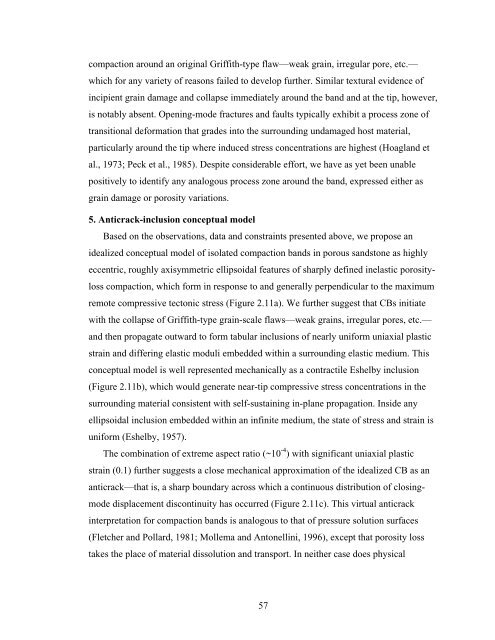structural geology, propagation mechanics and - Stanford School of ...
structural geology, propagation mechanics and - Stanford School of ...
structural geology, propagation mechanics and - Stanford School of ...
You also want an ePaper? Increase the reach of your titles
YUMPU automatically turns print PDFs into web optimized ePapers that Google loves.
compaction around an original Griffith-type flaw—weak grain, irregular pore, etc.—<br />
which for any variety <strong>of</strong> reasons failed to develop further. Similar textural evidence <strong>of</strong><br />
incipient grain damage <strong>and</strong> collapse immediately around the b<strong>and</strong> <strong>and</strong> at the tip, however,<br />
is notably absent. Opening-mode fractures <strong>and</strong> faults typically exhibit a process zone <strong>of</strong><br />
transitional deformation that grades into the surrounding undamaged host material,<br />
particularly around the tip where induced stress concentrations are highest (Hoagl<strong>and</strong> et<br />
al., 1973; Peck et al., 1985). Despite considerable effort, we have as yet been unable<br />
positively to identify any analogous process zone around the b<strong>and</strong>, expressed either as<br />
grain damage or porosity variations.<br />
5. Anticrack-inclusion conceptual model<br />
Based on the observations, data <strong>and</strong> constraints presented above, we propose an<br />
idealized conceptual model <strong>of</strong> isolated compaction b<strong>and</strong>s in porous s<strong>and</strong>stone as highly<br />
eccentric, roughly axisymmetric ellipsoidal features <strong>of</strong> sharply defined inelastic porosity-<br />
loss compaction, which form in response to <strong>and</strong> generally perpendicular to the maximum<br />
remote compressive tectonic stress (Figure 2.11a). We further suggest that CBs initiate<br />
with the collapse <strong>of</strong> Griffith-type grain-scale flaws—weak grains, irregular pores, etc.—<br />
<strong>and</strong> then propagate outward to form tabular inclusions <strong>of</strong> nearly uniform uniaxial plastic<br />
strain <strong>and</strong> differing elastic moduli embedded within a surrounding elastic medium. This<br />
conceptual model is well represented mechanically as a contractile Eshelby inclusion<br />
(Figure 2.11b), which would generate near-tip compressive stress concentrations in the<br />
surrounding material consistent with self-sustaining in-plane <strong>propagation</strong>. Inside any<br />
ellipsoidal inclusion embedded within an infinite medium, the state <strong>of</strong> stress <strong>and</strong> strain is<br />
uniform (Eshelby, 1957).<br />
The combination <strong>of</strong> extreme aspect ratio (~10 -4 ) with significant uniaxial plastic<br />
strain (0.1) further suggests a close mechanical approximation <strong>of</strong> the idealized CB as an<br />
anticrack—that is, a sharp boundary across which a continuous distribution <strong>of</strong> closing-<br />
mode displacement discontinuity has occurred (Figure 2.11c). This virtual anticrack<br />
interpretation for compaction b<strong>and</strong>s is analogous to that <strong>of</strong> pressure solution surfaces<br />
(Fletcher <strong>and</strong> Pollard, 1981; Mollema <strong>and</strong> Antonellini, 1996), except that porosity loss<br />
takes the place <strong>of</strong> material dissolution <strong>and</strong> transport. In neither case does physical<br />
57
















